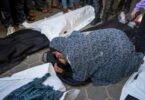Tallha Abdulrazaq
Abu Bakr al Baghdadi’s video appearance is an attempt to revive the morale of a group that has suffered heavy losses and is looking to rebrand itself. The self-proclaimed “Caliph” of the Daesh terror group’s imaginary global Muslim community is back.
Abu Bakr al-Baghdadi, whose real name is Ibrahim Awwad al Samarrai, appeared for the first time in almost five years on Monday, after Daesh propagandists from the Al Furqan media network released a video showing their leader explaining recent losses in Baghouz in Syria as well as discussing more recent terror attacks like the Sri Lanka Easter bombings that claimed hundreds of innocent lives, many of whom were Christians.
Bolstering Daesh’s ailing morale: So why has Baghdadi decided to make an appearance now? What coaxed him to temporarily risk putting his head above the parapet? Catching a glimpse of Baghdadi is about as rare as happening upon a winning lottery ticket.
Apart from a single appearance declaring the establishment of the Daesh caliphate from the pulpit of the now destroyed Grand Nuri Mosque in Mosul in 2014, Baghdadi has avoided cameras like the plague. However, in the latest video, the shadowy and elusive terrorist leader is now sporting a grey and henna-dyed red beard and was seen sat with an assault rifle on one side with three of his anonymised lieutenants to his other side.
Aside from speaking haltingly, he seemed to be in robust health, giving the lie to so-called “testimonies” of former lieutenants who were captured by US-led coalition forces and are now on death row in Iraq. Although it is near impossible to confirm the veracity of the almost 20-minute-long video, it’s clear that its release is designed to bolster the morale of Daesh supporters and militant cells around the world. Their morale would have undoubtedly been rattled after Daesh’s territorial caliphate was blasted into oblivion, along with tens of thousands of innocent lives, not that they would have cared about them.
However, through his reappearance and by claiming deadly attacks like Sri Lanka as his organisation’s doing, Baghdadi will have stiffened the spines of those still fighting in Iraq and Syria who were probably wondering where the caliph they had come to fight for was. Numerous reports from both Russian and American sources suggested that Baghdadi was dead or dying after being caught in airstrikes or other military action as he hid and his ‘caliphate’ steadily shrunk. Baghdadi may have also motivated terror cells and lone wolves around the world to plan their own attacks that Daesh can attach its franchised-out brand to. Daesh fanatics will be inspired to fight for the “spiritual caliphate” to perhaps one day return to a territorial one. In this way, the Daesh brand can grow both in impact and perception, attracting more followers to fill out its ranks after losing thousands from trying to hold territory in Iraq and Syria.
Returning to the Al Qaeda model: While Baghdadi must have been involved in the running of the terror organisation during its earlier phases and up until the tide started turning against Daesh in 2015 and 2016, the strategic realities he faces has meant that he has been forced to relinquish more and more control to his lieutenants. As Daesh’s territory and manpower were reduced, it turned from a land-occupying force akin to a poorly equipped conventional land army back to the loosely controlled asymmetric warfare organisation it began as, to survive and continue fighting. Now that Daesh’s territory has been completely taken from its grasp and its fighters are being hunted down and pursued in more traditional intelligence-led counterterrorism operations, even the command Baghdadi had relinquished to local commanders has had to be further diluted and delegated to small cells.
This arguably shows that he is more of a spiritual and symbolic leader than an actual commander and strategic player. This reality would not reduce his propaganda value, both to Daesh who will continue to proffer him up as some chosen one, as well as to the United States, Russia, or other state actors who would claim a huge propaganda victory if they were to capture or kill him. While Baghdadi began within the organisation known as Al Qaeda in Iraq before he and others created Daesh and publicly fell out with their parent organisation, it would seem clear that, following the abject failure of the caliphate project, Daesh is now reverting to the Al Qaeda model of decentralised command and global terrorism rather than the centralised and localised caliphate that has only just been dismantled at great cost.
This will make it even harder to dismantle Daesh. It took almost a decade for US special forces to track down and kill Osama bin Laden and, even then, Al Qaeda is still active around the world. With Daesh able to use its credentials as the only extremist group to have ever established, no matter how temporary, a caliphate, it will likely be able to endure to a higher degree than its progenitor.






